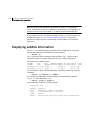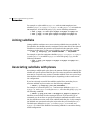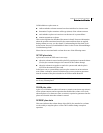
Chapter
6
Creating and
administering plexes
This chapter describes how to create and maintain plexes. Plexes are logical
groupings of subdisks that create an area of disk space independent of physical
disk size or other restrictions. Replication (mirroring) of disk data is set up by
creating multiple data plexes for a single volume. Each data plex in a mirrored
volume contains an identical copy of the volume data. Because each data plex
must reside on different disks from the other plexes, the replication provided by
mirroring prevents data loss in the event of a single-point disk-subsystem
failure. Multiple data plexes also provide increased data integrity and reliability.
Note: Most VxVM commands require superuser or equivalent privileges.
Creating plexes
Note: Plexes are created automatically if you use the vxassist command or the
Veritas Enterprise Administrator (VEA) to create volumes. For more
information, see “Creating a volume” on page 238.
Use the
vxmake command to create VxVM objects, such as plexes. When creating
a plex, identify the subdisks that are to be associated with it:
To create a plex from existing subdisks, use the following command:
# vxmake [-g diskgroup] plex plex sd=subdisk1[,subdisk2,...]
For example, to create a concatenated plex named vol01-02 from two existing
subdisks named mydg02-01 and mydg02-02 in the disk group, mydg, use the
following command:
# vxmake -g mydg plex vol01-02 sd=mydg02-01,mydg02-02


















